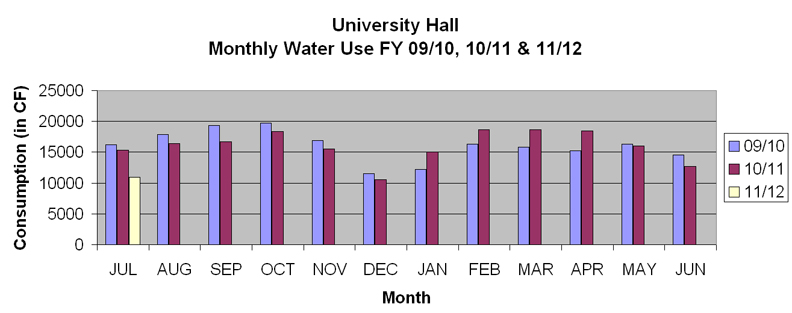PROJECT AREA: WATER
Water conservation is the most cost-effective and environmentally-friendly way to reduce our demand for water. Not only will this stretch our limited freshwater supplies further, it will put less pressure on our sewage treatment facilities, reduce unnecessary energy use for water heating, and reduce utility bills. What many people do not realize is that the distribution of water requires a lot of energy use. 6.5% of the energy used in California is for pumping and treating water—in fact, pumping water south (and uphill) in the State Water Project accounts for 2–3% of all electricity use in California.
During the annual CACS Sustainability Summit in April 2011, Chancellor Birgeneau announced the first water reduction goal for UC Berkeley: 10% below 2008 levels by 2020. With other campus stakeholders, PP-CS will play an important role to help campus reach those goals.
Restroom and Water Auditing
Training at 2000 Carleton - October 2009
PP-CS and EBMUD have collaborated to train student group Building Sustainability at Cal (BS@C) members on water auditing. EBMUD professionals were invited to teach how to conduct an accurate audit of water consumption on campus restrooms and read different types of water meters. PP-CS' plumbers were also invited to meet the students and discuss campus water conservation.


Replacing Sink Aerators
Many campus facuets originally ran at 2.5 gpm or more but more efficient aerators that run at 0.5 gpm are available. With BS@C, PP-CS Replaced 316 sink aerators in 12 campus buildings in 2009.
Bathroom Toilet and Urinals Conversions
With limited maintenance budgets, one efficient way to convert existing older toilet and urinal fixtures to low-flush fixtures is to install water efficiency kits instead of completely replacing the fixtures.
University Hall
As of May 2011, water efficiency kits were installed for 41 toilets and 16 urinals at University Hall to convert them to low-flow. Previously, the toilets and urinals used 3.5 gpf. With the new conversion kits, the toilets now use 1.6 gpf and the urinals use 1.2 gpf. The chart below shows the water consumption from fiscal year 2009/10 to the beginning of the fiscal year 2011/12. In June and July 2011, there was a 20% average reduction in water consumption when compared to June and July 2010. The total cost of the project was about $14,500 and the expected payback period is 3-4 months. This project was also referenced in an Daily Cal article on October 27, 2011.

Source: PP-CS Utilities Engineering, July 2011
Dwinelle Hall
A similar bathroom toilet and urinal conversion project like the University Hall project is currently underway at Dwinelle Hall.
